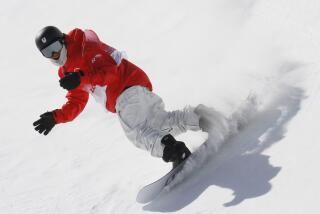Shiver Your Way to Weight Loss? It Might Work, But Don’t Try It
- Share via
WASHINGTON — If you stay out in the bitter cold, you could shiver off some of that holiday fat -- if you don’t mind risking death.
Shivering uses lots of calories, but researchers say you’d do yourself more good simply by exercising outdoors. The heat you generate by exercise will keep you warm.
“Shivering is a workout,” said Ira Jacobs, head of the environmental physiology section of Canada’s Defense and Civil Institute of Environmental Medicine, Toronto. “But I wouldn’t advise that. If you are shivering, you are cold, and you run the risk of hypothermia.”
Hypothermia, a slowing and chilling of the body as it’s exposed to cold, can cause death.
Shivering can raise your metabolic rate, the level at which you burn calories, to three-to-five times your rate at rest, said Jacobs.
Not that he expects anyone to try it. “Shivering is not a comfortable experience, if you do it for a long time,” Jacobs said. “I would not recommend it as a method of weight loss.”
Working out in the cold is a better way to cook, experts say.
“Once you get rolling on your run, your body temperature rises and everything is the same,” said Andrew J. Young, a research physiologist at the U.S. Army Research Institute of Environmental Medicine, Natick, Mass. “You could increase your metabolism to four-to-six times your resting level.”
Of course, that assumes maximum cold, said Col. E. Wayne Askew, chief of Military and Nutrition Research at Natick. How much you burn depends on how cold it gets, he said. If you go from 70 degrees out to freezing, you might double your caloric requirements, he said.
If you get rolling on a walk instead, you will burn some calories, but maybe not enough to offset the shiver, Young said.
The additional heat generated by a vigorous workout can keep you comfortable in normal workout clothes under normal winter conditions. “Heat production will offset heat losses,” Jacobs said.
“On a very, very cold day, you’d start to shiver,” Young said.
The worse the winter weather, the more calories you can burn, but that’s primarily because it takes more energy to move in heavy clothes and slog through snowdrifts, Jacobs and Young said. How many more calories depends on how much work you do.
And research has not established how much fat you’ll burn, Askew said. Much of your calories may come from carbohydrates, he said.
Canadian soldiers in the Arctic can tack on an additional 10% in caloric expenditure, said Jacobs, who has camped with the troops.
This doesn’t mean cold weather camping is for everyone.
“If you’re not an experienced outdoorsman, winter camping is dangerous and you shouldn’t do it,” Young said. “There’s a lot of opportunity for false steps and mistakes that could kill you.”
Jacobs’ colleague, Michel B. Ducharme, a thermal physiologist, is somewhat less concerned.
“I’ve been doing that for years,” he said. “I’m a mountaineer.”
You should know the risks, study the sport, and start with someone who knows what he’s doing, Ducharme said.
“Try it first in your back yard,” he said. “If you make a mistake, you only have to come back home.”
Staying dry is crucial to staying warm, Ducharme said.
“Water has a thermal conductivity 25 times higher than air. If you have water in your clothing or sleeping bag, heat transfer would be faster than in dry clothing.”
Some people don’t realize that sweaty clothes can be dangerous, he said.
“Instead of drying their wet clothing, they keep their wet clothing on,” Ducharme said. “They get cold, and it’s easy to get into hypothermia.”


